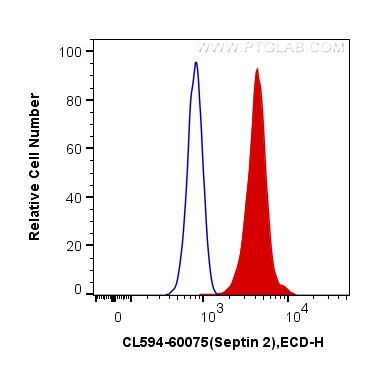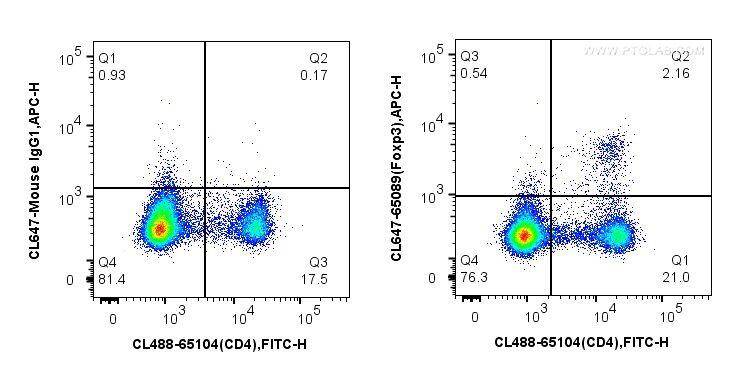- Featured Product
- KD/KO Validated
CoraLite®594-conjugated Septin 2 Monoclonal antibody
Septin 2 Monoclonal Antibody for FC (Intra)
Host / Isotype
Mouse / IgG1
Reactivity
human, mouse, rat
Applications
FC (Intra)
Conjugate
CoraLite®594 Fluorescent Dye
CloneNo.
2F3B2
Cat no : CL594-60075
Synonyms
Validation Data Gallery
Tested Applications
| Positive FC detected in | K-562 cells |
Recommended dilution
| Application | Dilution |
|---|---|
| Flow Cytometry (FC) | FC : 0.40 ug per 10^6 cells in a 100 µl suspension |
| It is recommended that this reagent should be titrated in each testing system to obtain optimal results. | |
| Sample-dependent, Check data in validation data gallery. | |
Product Information
CL594-60075 targets Septin 2 in FC (Intra) applications and shows reactivity with human, mouse, rat samples.
| Tested Reactivity | human, mouse, rat |
| Host / Isotype | Mouse / IgG1 |
| Class | Monoclonal |
| Type | Antibody |
| Immunogen | Septin 2 fusion protein Ag1946 |
| Full Name | septin 2 |
| Calculated Molecular Weight | 41 kDa |
| Observed Molecular Weight | 42-45 kDa |
| GenBank Accession Number | BC014455 |
| Gene Symbol | SEPT2 |
| Gene ID (NCBI) | 4735 |
| RRID | AB_2883416 |
| Conjugate | CoraLite®594 Fluorescent Dye |
| Excitation/Emission Maxima Wavelengths | 588 nm / 604 nm |
| Form | Liquid |
| Purification Method | Protein G purification |
| Storage Buffer | PBS with 50% Glycerol, 0.05% Proclin300, 0.5% BSA, pH 7.3. |
| Storage Conditions | Store at -20°C. Avoid exposure to light. Stable for one year after shipment. Aliquoting is unnecessary for -20oC storage. 20ul sizes contain 0.1% BSA. |
Background Information
Septin 2, also named as DIFF6, KIAA0158, NEDD5, belongs to the septin family. It is a filament-forming cytoskeletal GTPase. Septin 2 is required for normal organization of the actin cytoskeleton. It plays a role in ciliogenesis and collective cell movements. Septin 2 is coordinated expression with Septin 6 and Septin 7. (PMID:21737677)
Protocols
| Product Specific Protocols | |
|---|---|
| FC protocol for CL594 Septin 2 antibody CL594-60075 | Download protocol |
| Standard Protocols | |
|---|---|
| Click here to view our Standard Protocols |



